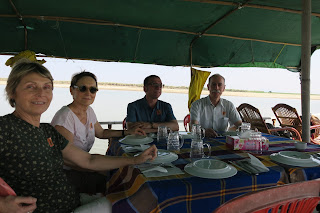The Irrawaddy or, officially, Ayeyarwady River (also spelt Ayeyarwaddy, eventually from Indic revatī "abounding in riches") is a river that flows from north to south through Burma. It is the country's largest river and most important commercial waterway. Originating from the confluence of the N'mai and Mali rivers, it flows relatively straight North-South before emptying through the Irrawaddy Delta into the Andaman Sea. Its drainage basin of about 404,200 square kilometres (156,100 sq mi) covers a large part of Burma. After Rudyard Kipling's poem, it is sometimes referred to as 'The Road to Mandalay'.
As early as the sixth century, the river was used for trade and transport. Having developed an extensive network of irrigation canals, the river became important to the British Empire after it had colonized Burma. The river is still as vital today, as a considerable amount of (export) goods and traffic moves by river. Rice is produced in the Irrawaddy Delta, irrigated by water from the river.
|
Departure from Mandalay. |
|
Entering the boats. |
|
Taking a seat on one of the boats. |
|
View of the riverbank from the boat. |
|
Arrival to Mingun.
|
|
Departure from Mingun. |
|
Having lunch on the boat. |
|
Golden Dragon Boat. |
|
Irrawaddy Ava Bridge (left) and Sun U Ponnyashin Pagoda (right). |
|
Sun U Ponnyashin Pagoda (left) and Sin Boe Pagoda (right). |
|
Sun U Ponnyashin Pagoda (left) and Si Mi Ma Nyein Pagoda (right). |
|
Docking the boat on the river bank. |
|
Arrival to Sagaing.
|
|
The three little monks pose for a photo. |
See also
Source
Location
























